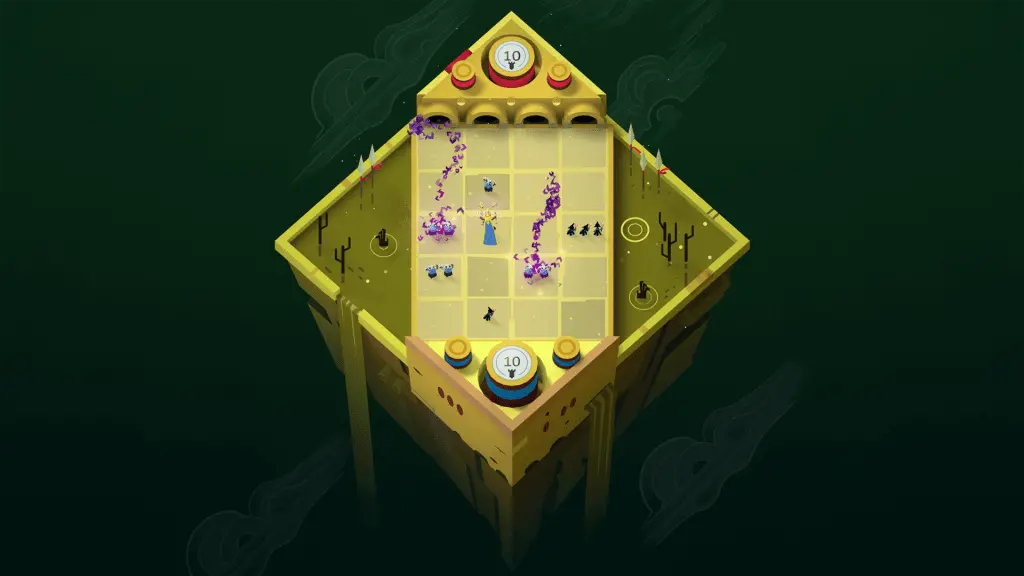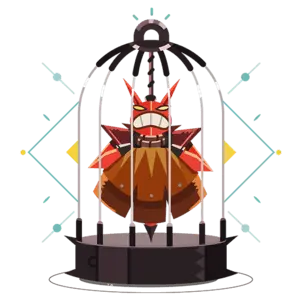
D1 with SF Commons
By Kitty · PlaystyleBack to guides
Fair disclaimer: I am by no mean the most talented player. I have been playing on and off since late 2018 and reached Diamond 1 in May 2019, and did so every month since.
As a free-to-play player, my collection is not very developed. I originally reached Diamond with a Winter rush deck, and kept playing Winter for a long while. Eventually I switched to Shadowfen for a change of pace, but did not have a lot of options. So thanks to kind help from The_mirc, I came up with a deck made of ![]() 11 common cards and
11 common cards and ![]() 1 rare card.
1 rare card.
I am still rocking that deck in Diamond 1 as of writing (June 2020), waiting for my collection to evolve so I can experiment with other things. It’s a strong deck that’s easy to make, and that’s what we are going to focus on today.
The deck
Before we get into the gameplay and situations, let’s have a look at the deck itself. As I mentioned before, it is made of ![]() 11 common cards, and
11 common cards, and ![]() 1 rare card. There might be a way to replace Green Prototypes with a common card for the sake of having a fully common deck, but that’s for another day.
1 rare card. There might be a way to replace Green Prototypes with a common card for the sake of having a fully common deck, but that’s for another day.
A few interesting points to note about that deck:
- It’s fast. It has 0 structure and 9 units, including 4 runners. Its cell-on-play is 1.08, which is particularly fast.
- It’s cheap. The average mana cost is exactly 3, with 6 cards being playable as the first player (excluding Toxic Sacrifice), and 8 or 9 as the second.
- It’s simple. With 4 runners of various costs, this deck has a single win condition: running through the baseline and knocking down the base health quickly and aggressively.
Looking at the mana curve graph, we can see that the first few turns are pretty stable, which is a good quality of a deck. Turn mana 6 is the most risky one, with possibly (although not so likely) some 1 mana loss, 2 in the worst case scenario.
Another interesting consideration is that by turn mana 5, it is already possible to play all 4 cards if we have to use Toxic Sacrifice. The likelihood of being able to play the full hand increases rapidly at every turn to pass the 50% threshold by turn mana 9 and 90% threshold at mana 12.
The cards
Cheap Drops
This deck has 2 main facets: cheap drops and runners. The cheap drops are Green Prototypes, Summon Militia, Gifted Recruits, Dubious Hags and to a lesser extent First Mutineer and Westwind Sailors. That’s half the deck.
Like in any deck, these cards serve two purposes: being able to defend by having cheap units with movement—and being able to push the frontline quickly and reliable in order to allow the runners to do their job. Which leads us to our next main point.
Runners
The reason this deck is so fast is because it has an unusually high amount of runners (4). Indeed, this is the bread and butter of this deck: we need to pass the runners through the baseline. That’s why it is good to have several of them, and of different costs.
What is interesting about this configuration is that our runners all have a different mana cost (3, 4, 5 and 7), making it possible to use a runner at basically any mana turn in the game.
Another quirk of the setup which we learn to turn into our advantage is the ability of First Mutineer not impacting other pirates. Fortunately, we run Westwind Sailors and Bluesail Raiders, both of which are immune to that discard penalty.
If you happen to have Wild Saberpaws at level 3 or more, it might be a good idea to replace Summon Militia with it. Not only does it grant another runner, but it also makes for a less random target for Toxic Sacrifice combos.
On a similar note, Limelimbs is a better alternative to First Mutineer since it comes without any penalty, and varies races to avoid being subject to Beasts of Terror’s ability.
Witches of the Wild
Witches of the Wild is such a versatile card that it has to take part in most Shadowfen decks, this one being no exception. At level 5, it can have up to 29 strength value for 4 mana in perfect conditions, and easily averages between 11 and 17 value. That’s too good to pass.
Spells
In this deck, spells are mainly here to tempo the game and counter aggressive push long enough to maintain the frontline or end the game. They are not really used offensively per se.
Toxic Sacrifice is included because it provides excellent board control. Not only does it make it possible to counter early pushes, but it also can clear our own units if they are in the way of lethal.
Originally, I ran a slight variation of this deck with Northsea Dog instead of Confinement but it did not work. Northsea Dog ends up being cycled for most of the game and does not help defending whatsoever. Confinement is here to dramatically slow down a heavy push, and to counter Elders such as Hairy Chestnuts and Bucks of Wasteland.
Playstyle and Strategies
General strategy
The main idea is to push fast early on and establish board dominance near the enemy’s baseline, or in the mid-field. From there, it’s a bit of an endurance game to keep control of the board for the next few turns while the mana increases.
When the game reaches turn mana 10/11, we will start seeing a lot of opportunities for playing two runners in the same turn, or one runner + a move to keep board presence. Knowing the damage possibilities of combining 2 runners is therefore important (the card level can be adjusted in the top left corner of the table):
| First Mutineer | Warfront Runners | Bluesail Raiders | Salty Outcasts | |
|---|---|---|---|---|
| First Mutineer | 3 mana / 5 damage | 7 mana / 11 damage | 8 mana / 12 damage | 10 mana / 15 damage |
| Warfront Runners | 7 mana / 11 damage | 4 mana / 6 damage | 9 mana / 13 damage | 11 mana / 16 damage |
| Bluesail Raiders | 8 mana / 12 damage | 9 mana / 13 damage | 5 mana / 7 damage | 12 mana / 17 damage |
| Salty Outcasts | 10 mana / 15 damage | 11 mana / 16 damage | 12 mana / 17 damage | 7 mana / 10 damage |
Toxic Sacrifice should be used sporadically and with caution. Keeping the front line is usually more important than clearing the opponent’s baseline. Similarly, Confinement can be cycled a lot and used on Elders or to negate a heavy push (Operators, Potion of Growth…).
Openings
Thanks to the variety of cards costing 3 mana or less, there are actually quite a lot of different openings.
The ideal opening is Green Prototypes into either Gifted Recruits or Dubious Hags, giving 2 movements with 2 units for 3 mana. Another decent opening is Gifted Recruits or Dubious Hags into Summon Militia.
- Green Prototypes
1
 5
5 - Summon Militia
1
 5
5 - Dubious Hags
2
 5
5 - Gifted Recruits
2
 5
5 - Toxic Sacrifice
2
 5
5 - Confinement
3
 5
5 - First Mutineer
3
 5
5 - Westwind Sailors
3
 5
5 - Warfront Runners
4
 5
5 - Witches of the Wild
4
 5
5 - Bluesail Raiders
5
 5
5 - Salty Outcasts
7
 5
5
With 4 units costing 4 or more mana and 2 spells targeting enemy units, it is important to note that, while unlikely, there is a possibility of having nothing to play on the first hand as a first player. In that case, I would recommend keeping Toxic Sacrifice (if in the hand) to be able to defend and retake board control a few turns later.
In most scenarios, cycling Salty Outcasts, Bluesail Raiders, Confinement or Toxic Sacrifice (in that order of preference) is usually the way to go for the first hand. The idea is to optimise the chances to play 2 to 3 cards a turn in the first few rounds of the game.
When playing second and having the opportunity of playing Gifted recruits and Dubious Hags, I find preferable to play Dubious Hags the further away from our baseline as possible. What we don’t want is the hag from the on-death trigger to spawn on our baseline and reduce our opportunities.
For more in-depth information about the drawing algorithms and cycling mechanics, be sure to read the guide on drawing.
Against Winter Pact
Most Winter decks tend to be quite heavy, and aim to take full control of the board by mid/late game, eventually pushing the frontline until they have lethal. The goal is to finish before they get to that point.
It is critical to preserve high board presence at all cost. There is usually no coming back from a board clear past 8 mana against a Winter deck. We absolutely need to stay up front until turn mana 10/11 where we can start passing heavy runners in.
When facing a Winter freeze deck, we might be facing difficulty moving our runners through their baseline because they keep freezing our cheap units there. This is one of the cases where using Toxic Sacrifice in an offensive way can pay off.
Consider the following board where Gifted Recruits have been frozen by a Moment’s Peace onto the Frozen Core. By playing Toxic Sacrifice on the Gifted Recruits, we not only kill the Rockworkers, but also free the way for Salty Outcasts to run it.
- Green Prototypes
1
 5
5 - Summon Militia
1
 5
5 - Dubious Hags
2
 5
5 - Gifted Recruits
2
 5
5 - Toxic Sacrifice
2
 5
5 - Confinement
3
 5
5 - First Mutineer
3
 5
5 - Westwind Sailors
3
 5
5 - Warfront Runners
4
 5
5 - Witches of the Wild
4
 5
5 - Bluesail Raiders
5
 5
5 - Salty Outcasts
7
 5
5
Against Swarm of the East
There are two archetypes of Swarm decks: early rush and control (which usually involves Queen of Herds and/or Bucks of Wasteland). It is helpful to try to guess early which kind of deck we’re facing.
When facing a rush deck, such as Reckless Rush, I would recommend defending. With 4 runners costing 3/4/5/7 mana, our deck is not a particularly early game rush and we have opportunities to come back during the mid-game. So defending to counter-attack around turn mana 10/11 has proven to be a decent approach.
If the opponent starts the game with a Shady Ghoul and we happen to have a Toxic Sacrifice in our hand, it might be interesting not to cycle it to be able to clear the upcoming cheap drops (Green Prototypes, Gifted Recruits, Doppelbocks, Head Start…). Being able to reset the line of an early Swarm rush can make the difference between victory and defeat.
When facing a control Queen of Herds deck however, things can get more tricky, especially when she is paired with a high-level Bucks of Wasteland. Against such decks, what’s important is maintaining the front-line at all cost. Confinement is kept especially for Bucks so that Toxic Sacrifice can be used without risking buffing the entire raid.
Against Ironclad Union
When facing an Ironclad deck, one has to be ready to be countered by Windmakers. The worst that can happen is our frontline being reset for only 4 mana because we set 2 units side-by-side on the opponent’s baseline. Therefore, it might be interesting to split the attack on both sides.
This will not guarantee keeping the frontline, but this will increase the chances a little, especially if the opponent does not have a particularly cheap deck.
- Green Prototypes
1
 5
5 - Summon Militia
1
 5
5 - Dubious Hags
2
 5
5 - Gifted Recruits
2
 5
5 - Toxic Sacrifice
2
 5
5 - Confinement
3
 5
5 - First Mutineer
3
 5
5 - Westwind Sailors
3
 5
5 - Warfront Runners
4
 5
5 - Witches of the Wild
4
 5
5 - Bluesail Raiders
5
 5
5 - Salty Outcasts
7
 5
5
When facing a structure deck, it’s important to go upfront and destroy or minimise the impact of towers. Seeing a Doctor Mia or a cycled Fortification Tonic in the early turns is a good indicator that either a Siege Assembly or an Upgrade Point are coming, so it’s important to move fast to counter before the opponent starts steamrolling.
Against Tribes of the Shadowen
I personally find the Shadowfen mirror matches to be the most difficult. Shadowfen, as we know, has a lot of AoE such as Toxic Sacrifice, Crimson Sentry or Witches of the Wild. As a result, it is relatively trivial to clear the line, making it sometimes difficult to come back.
Be mindful of positioning. Toxic Sacrifice cannot really be avoided given it has a huge area of effect, but the risks of an overvalued Witches of the Wild can and should be controlled.
In the following situation, Dubious Hags are better played on the opposite side rather than in the top left corner. Otherwise that would be a prime situation for Witches of the Wild, and could even be a full clear if the opponent has Toxic Sacrifice or Green Prototypes.
Thanks to this placement, clearing both units become more difficult. It is still very possible of course, but with 5 mana, the options are limited. Even Toxic Sacrifice becomes more complex to exploit unless they have a static unit to put in the middle.
- Green Prototypes
1
 5
5 - Summon Militia
1
 5
5 - Dubious Hags
2
 5
5 - Gifted Recruits
2
 5
5 - Toxic Sacrifice
2
 5
5 - Confinement
3
 5
5 - First Mutineer
3
 5
5 - Westwind Sailors
3
 5
5 - Warfront Runners
4
 5
5 - Witches of the Wild
4
 5
5 - Bluesail Raiders
5
 5
5 - Salty Outcasts
7
 5
5
To wrap up, this deck is a solid rush deck which remains viable in mid-game. It has the particularity of being composed almost exclusively of common cards, making it the perfect deck to reach Diamond 1 as a free-to-play player. I hope you like it. 💖
Looking to teach others and guide them towards glorious battles?
Have your own guide published.